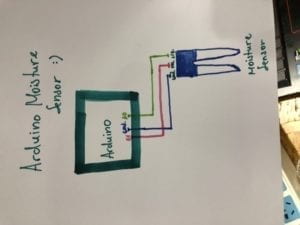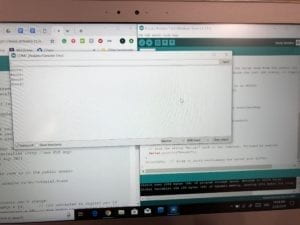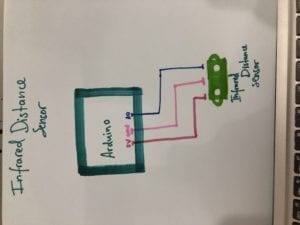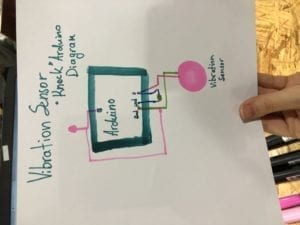3.1.19
Moisture Sensor: The Moisture Sensor can be used as if you were doing a simple analog read. Connect the sensors’ power and ground pins to the Arduino’s power and ground, respectively. This sensor’s signal pin can then be connected to an analog input pin.
Infrared Distance Sensor: Similar to the Moisture Sensor, the Infrared Distance Sensor can be used by implementing the connections and code from a simple analog read sketch. In the case of Infrared Distance Sensors, using the “map()” function can be helpful. This function maps the analog readings from the sensor to the distance between the sensor and the object.
Vibration Sensor: To create a Vibration Sensor you will need a piezo disk and a 1 mega ohm resistor. You can use the Knock example (Arduino>File>Examples>0.6Sensors>Knock). Otherwise, the Vibration Sensor can be used as a simple Analog input. If you use this sensor, please add a different output to your circuit, aside from the built-in LED.
Question 1:
What did you intend to assemble in the recitation exercise? If your sensor/actuator combination were to be used for pragmatic purposes, who would use it, why would they use it, and how could it be used?
I intended to assemble various electronic circuits involving sensors. For the vibration sensor, I intended to create a system that would respond to a knock input. If my sensor was used for pragmatic purposes, the vibration sensor could be used by a guitarist, to detect the vibrations of a guitar, and perhaps tune the guitar.
For the infrared distance sensor, the sensor would respond to interference from 4-30 meters away. A pragmatic purpose for this sensor would be as a night light, for those who have trouble seeing in the dark at night.
As for the moisture sensor, a very well known example would be to use it for people with plants, having the moisture sensor measure the humidity levels of the soil, regulating the moisture levels for the plant.
Question 2:
Code is often compared to following a recipe or tutorial. Why do you think that is?
Code is used to write programs. Programs are step by step instructions that tell the computer to execute certain functions. Recipes are also step by step instructions but telling others how to cook.
Question 3:
In Language of New Media, Manovich describes the influence of computers on new media. In what ways do you believe the computer influences our human behaviors?
The computer influences our human behaviors by altering our routine habits. Computers have become many people’s productivity tool, and many people rely on computers to function and get work done. Computers have also allowed us to share enormous amounts of information, and this saturation of sharing has spurred an obsession with showing our best sides and taking the perfect selfie. The computer encourages an increased amount of screen time and an increased amount of sharing, in a new way, via the internet.



